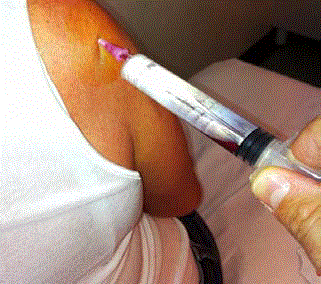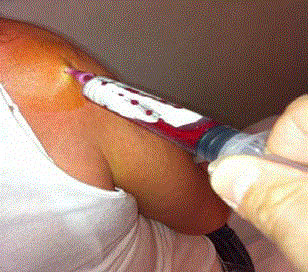Surgical Technique
“Dynamic” Needle Aspiration for Painful Hypertrophic Subacromial Bursa
Andrea Emilio Salvi*
Department of Orthopaedics and Traumatology, Civil Hospital of Chiari, Italy
*Corresponding author: Andrea Emilio Salvi, Department of Orthopaedics and Traumatology, Civil Hospital of Chiari, ASST Franciacorta, Via Cipro 30, 25124 Brescia, Italy
Published: 24 Aug, 2018
Cite this article as: Salvi AE. “Dynamic” Needle Aspiration
for Painful Hypertrophic Subacromial
Bursa. World J Surg Surgical Res.
2018; 1: 1040.
Keywords
Shoulder; Pain; Needle; Subacromial bursa
Surgical Technique
Shoulder pain is a very frequent complaint in primary care and the vast majority of painful shoulder problems are due to acute subacromial bursitis and bicipital tendinitis [1]. The subacromial bursa is prone to suffer proliferative or degenerative changes in patients with impingement syndrome. Normal subacromial bursa fluid is rarely thicker than 2 mm and tends to be located posteriorly, tending to undergo proliferative or degenerative changes in rotator cuff tendinopathies [2]. A study suggests that adhesion of the subacromial bursa increases impingement between the acromion and the insertion of rotator cuff tendons [3]. Normally, there is no communication between the subacromial bursa and the joint and it happens in full-thickness tears of the rotator cuff and effusion in bursa is frequently associated with shoulder pain. On this route, since removal of bursal tissues should be limited to the lesional tissue that interferes with subacromial motion [4], some findings highlight the importance of subacromial bursectomy to reduce inflammation in rotator cuff disease [5]. Since intra-articular or periarticular aspiration or injections are an integral part of the management of arthritis or periarthritis, the author has conceived a “dynamic” intraarticular technique that makes use of a needle dynamically guided by hand forward and backward that permits to mobilize and therefore aspirate the hypertrophic subacromial bursa. The patient is sit down on an ambulatory bed, with the hand of the affected shoulder lied down. The posterior subacromial space is found through pression of the thumb with the other fingers located anterior to the shoulder. An 18 G needle is then introduced into the subacromial space, parallel to the acromion. Maintaining the syringe under continuous aspiration (Figure 1), the needle is continuously moved forward and backward into the joint, with resultant drawing of coagulated subacromial bursal blood into the syringe (Figure 2). The procedure is carried out until no more blood is drawable. Then, a 4 mg (1 ml) vial of Cortisonic (Depo-Medrol) plus 1 ml of Lidocaine and 3 cc to 4 cc of saline solution is administered into the subacromial space to decrease inflammation and allowing the patient to participate in physical therapy. Oral NSAIDS therapy is suggested for the following days, preferably Indomethacin 50 mg 1 tablet a day after meal for 20/25 days. The author has performed this technique since 10 years with good results. Patient experiences immediate pain relief and increase of range of motion, complaining sometimes little pain during motion for some days at the insertion point on the deltoid tuberosity of the humerus, since muscle has been unused for a long time.
Figure 1
Figure 1
Needle introduced in subacromial space with piston syringe maintained completely pulled back to
ensure maximum vacuum.
Figure 2
Figure 2
Following some forward and backward movement of the needle
into the subacromial space, always maintaining the piston syringe completely
pulled back, it is possible to observe considerable quota of collected blood
into the syringe, resulting from the subacromial bursa.
References
- Calabro JJ, Londino AV, Eyvazzadeh C. Sustained-release indomethacin in the management of the acute painful shoulder from bursitis and/or tendinitis. Am J Med. 1985;79(4C):32-8.
- Sarkar K, Uhthoff HK. Ultrastructure of the subacromial bursa in painful shoulder syndromes. Virchows Arch A Pathol Anat Histopathol. 1983;400(2):107-17.
- Machida A, Sugamoto K, Miyamoto T, Inui H, Watanabe T, Yoshikawa H. Adhesion of the subacromial bursa may cause subacromial impingement in patients with rotator cuff tears: pressure measurements in 18 patients. Acta Orthop Scand. 2004;75(1):109-13.
- Ishii H, Brunet JA, Welsh RP, Uhthoff HK. "Bursal reactions" in rotator cuff tearing, the impingement syndrome, and calcifying tendinitis. J Shoulder Elbow Surg. 1997;6(2):131-6.
- Blaine TA, Kim YS, Voloshin I, Chen D, Murakami K, Chang SS, et al. The molecular pathophysiology of subacromial bursitis in rotator cuff disease. J Shoulder Elbow Surg. 2005;14(1 Suppl S):84S-9S.


